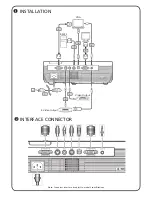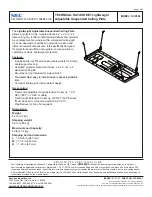
129
6. Installation and Connections
HDMI IN
HDMI OUT
Connecting an External Monitor
You can connect a separate, external monitor to your projector to simultaneously view on a monitor the computer
analog image you’re projecting.
• BNC(CV) component video signals and BNC(Y/C) S-video signals will not be output.
• Please refer to Page
when displaying the PIP/PBP screen.
NOTE:
• When outputting HDMI signals, turn on the power of the video device on the output side and keep it connected before inputting
video signals into this device. The HDMI OUT terminals of the projector are equipped with repeater functions. When a device is
connected to the HDMI OUT terminal, the resolution of the output signal is limited by the resolution supported by the connected
device.
• In the case of the HDMI OUT terminal of the projector, the theoretical number of units that can be connected in a series is seven.
The maximum number of units that can be connected may be reduced by the external environment and quality of the signal and
cable, etc. The number of units that can be connected may differ depending on the HDCP version, restriction on the number of
HDCP repeaters in the source device and the quality of the cable. The overall system needs to be checked in advance when build-
ing a system.
• When the [STANDBY MODE] is set to [NORMAL], video will not be output if the projector goes into the standby mode. Set the
mode to [NETWORK STANDBY], turn on the power of the transmission device and keep it in a connected state.
• When the [STANDBY MODE] of this device is set to [NORMAL], HDMI signals will not be output. To output HDMI signals, set the
[STANDBY MODE] to [NETWORK STANDBY], turn on the power supply of the transmission device and keep it connected.
• HDMI repeater function will not be functioned if switching terminals and putting in/pulling out the HDMI cable is performed on
the 2nd projector and after.
Computer cable (VGA) (not supplied)
HDMI cable (not supplied)
















































